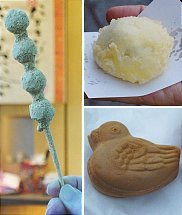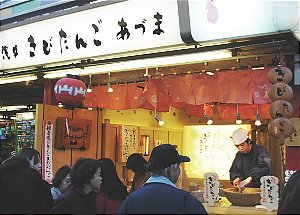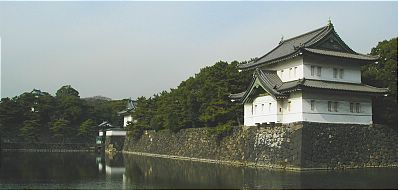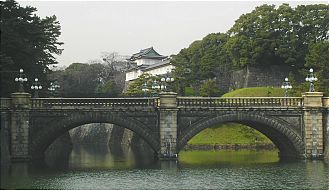Today is National Foundation Day in Japan. This is the day that the first Emperor was enthroned back in 656 BC. The holiday fell on a Saturday so the pace of business wasn't affected to much. However Right Wing activist where demonstrating and showing there compassion for the emperor, while Japanese Nazi parties where also demonstrating it was quiet an experience to take in.
I took the Gray Line Grand Full Day Tour throughout Tokyo to see the following sites.
1. TOKYO TOWER With 333 meters, Tokyo Tower is 13 meters taller than its model, the Eiffel Tower of Paris, and the world's tallest self-supporting steel tower. It was completed in the year 1958 as a symbol for Japan's rebirth as a major economic power, and serves as a television and radio broadcast antenna and tourist attraction. Visitors can ascend to the main observatory at 150 meters and the special observatory at 250 meters to get a bird's eye view of Tokyo. Under good weather conditions,Mount Fuji can be seen in the distance. A ride to the top floor, the special observatory, costs roughly 1500 Yen per adult.
 | | (683 x 1024 - 83K) | The Tokyo Tower, a clone of La Tour Eiffel built in the 60s to show how modern Japan was
|
| |
2. MEIJI SHRINE Featured a wedding ceremony. We got to see the wedding parade come through featuring the wife dressed in a white kimono and Groom dressed in traditional dress. The bride will change atleast three times during the day. The first is a White Japanese Traditional Dress. The reception has about 80 invited guests who bring monetary gifts to the new family. Monetary gifts should only be given in odd numbers so that it can not be evenly split. At the reception a more colorful traditional dress is worn and before the bride and groom leave a traditional western wedding dress will be worn. Divorce is low in Japan but is on the rising number as 1 in 5 marriages end in divorce.
 |
| Meiji Shrine |
Meiji Shrine (Meiji Jingu) is a shrine dedicated to the defied spirits of Emperor Meiji and his consort, Empress Shoken. In Shinto, it is not uncommon to enshrine the defied spirits of important personalities. Emperor Meiji was the first emperor of modern Japan. He was born in 1852 and ascended to the throne in 1868 at the peak of the Meiji restoration when the power was switched from the feudal Tokugawa government to the emperor. During the Meiji Period, Japan modernized and westernized herself to join the world's major powers by the time Emperor Meiji passed away in 1912.
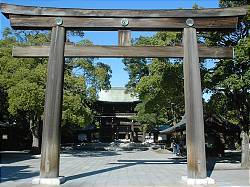
Torii (entrance gate) | 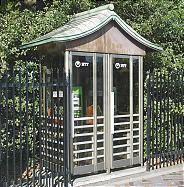
Public phone booth |
The Meiji Shrine was completed in 1920, and rebuilt after being destroyed in World War Two. It is located in a wooded park area next to Yoyogi Park in Tokyo. Various events and festivals are celebrated at the shrine throughout the year.
3.AKASAKA GUEST HOUSE The State Guest-House (Geihinkan; 迎賓館) is a facility in State Guest-House Akasaka Palace which the government of Japan accommodates visiting state dignitaries. Located in the Moto Akasaka area of Tokyo, the guest house took on its present function in 1974, having previously been a detached palace. The architect Katayama TokumaBaroque structure as a residence for the Crown Prince. The building has 15,000 m² of floor space, and together with a smaller structure in the Japanese style, occupies a 117,000 m² site. designed the neo-

- 4.NATIONAL DIET BUILDING is the place in which both the houses of the Diet of Japan are held. It is located in 1-chome, Nagatacho, Chiyoda Ward, Tokyo. Sessions of the House of Representatives take place in the left side and sessions of the House ocouncilorsrs in the right side. The Diet Building was completed in 1936 and is constructed entirely out of Japanese building materials. We only got to drive by this area so didn'tnt have angoodoo pictures of it.

History The construction of the building began in 1920; however, plans for the building date back to the late 1880s. The Diet met in temporary structures for the first fifty years of its existence because there was no agreement over what form its building should take.
5.IMPERIAL PALACE EAST GARDENThe Imperial Palace East Gardens (Kokyo Higashi Gyoen) are a part of the inner palace area and are open to the public, except on Mondays, Fridays and some special occasions (see links below). Admissions is free of charge.
The East Gardens are the former site of Edo Castle's innermost circles of defense, the honmaru ("main circle") and ninomaru ("secondary circle"). None of the main buildings remain today, but the moats, walls, entrance gates and several guardhouses still exist.
Edo Castle was the residence of the Tokugawa shogun who ruled Japan from 1603 to 1867. Emperor Meiji also resided there from 1868 to 1888 before moving to the newly constructed Imperial Palace.
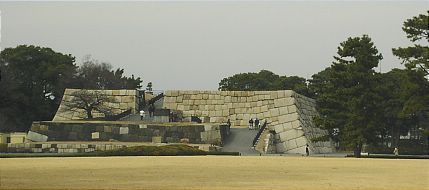 The remains of the castle tower
The remains of the castle tower- A wide lawn and the remaining foundation of the former castle tower can be found on top of the hill, where the castle's innermost buildings once stood. The castle tower was completed in 1638 as the tallest castle tower in Japan's history. But only a few years later in 1657, it was destroyed by citywide fires and has not been rebuilt ever since.
In place of the former buildings in the secondary circle of defense (ninomaru) at the foot of the hill, a nice Japanese style garden has been created.
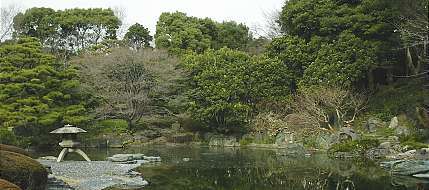
- 6. GINZA SHOPPING DISTRICT One of the most expensive in the city. This area is very expensive due to the high land values of the area. The rent can bnearlyly 30000 US per month if not more. This area had Japan`s first Starbucks and McDonalds. I looked for a camera here butdidn'tnt find anything I liked.
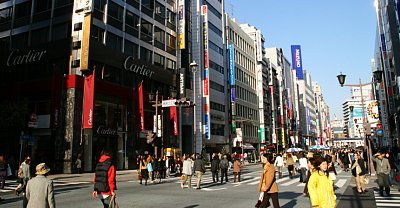
The Ginza is Tokyo's most famous upmarket shopping, dining and entertainment district, featuring numerous department stores, boutiques, art galleries, restaurants, night clubs and cafes.
One square meter of land in the district's center is worth more than ten million yen (more than 100,000 US dollars), making it one of the most expensive real estate in Japan. It is where you can find the infamous $10 cups of coffee and where virtually every leading brand name in fashion and cosmetics has a presence.
From 1612 to 1800, today's Ginza district was the site of a silver coin mint (Japanese: ginza), after which the district was eventually named. The Ginza evolved as an upmarket shopping district following the 1923 Great Kanto Earthquake.
A visit to the Ginza is most pleasant on a weekend afternoon, when the central Chuo Dori gets closed to traffic and become a large pedestrian zone. The closure takes place from 14:00 to 17:00 on Saturdays and from 12:00 to 17:00 on Sundays (until 18:00 from April through September).
- 8. TASAKI PEARL GALLERY
- It was interesting to learn exactly how cultured pearls where made by manipulating the actual clams. It was a long 2 to 3 years process.
 |
| Sumida River Cruise |
- 9. SUMIDA RIVER CRUISE
- Got to take th boat and see many unique buildings along the Sumida River. The most important river in Tokyo. Many homeless people can be seen along the shore in blue tents There are only about 4000 homeless people in Tokyo.
- 10. ASAKUSA KANNON TEMPLE and NAKAMISE SHOPPING STREET This area was very unique and I got to see lots of people shopping for unique items here. It was extremely jammed packed. My camera died here and so don'tnt have many pictures but these came from the internet. Japan is a volcanic island so they have many earthquakes each year. These temples remain through these because they are builcompletelyly on jointery. These are very beautiful hand crafted temples.
- Sensoji (also known as Asakusa Kannon Temple) is a temple located in Asakusa, a central part of the Shitamachi. Shitamachi ("downtown") is the old town of Tokyo.
- The legend says that in the year 628, two brothers fished a statue of Kannon, the goddess of mercy, out of the Sumida river, and even though they put the statue back into the river, it always returned to them. Consequently, Sensoji was built there for the goddess of Kannon. The temple was completed in 645, making it Tokyo's oldest temple.
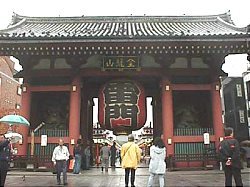 Kaminarimon, the outer gate Kaminarimon, the outer gate | 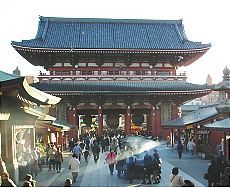 Hozomon, the main gate Hozomon, the main gate |
When approaching the temple, visitors first enter through the Kaminarimon (Thunder Gate), the outer gate of the Sensoji and one of the most popular sights of traditional Tokyo. A shopping street of over 200 meters, called Nakamise, leads from the outer gate to the temple's main gate, the Hozomon. Besides typical Japanese souvenirs such as yukata and folding fans, various traditional local snacks from the Asakusa area are sold along the Nakamise. The shopping street has a history of several centuries.
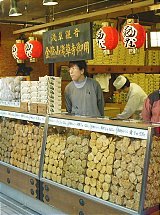 Osenbei (rice crackers) Osenbei (rice crackers) | 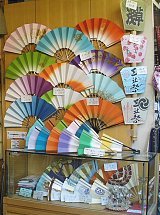 Folding Fans Folding Fans |  Yukata and T-shirts Yukata and T-shirts |
| from left to right: Kibidango - Skewered kibi-balls covered with soybean powder; top: Agemanju - deep fried manju (soft cake with red bean paste filling); bottom: Ningyoyaki - small cake with red bean paste filling; Kibidango Shop |
Beyond the Hozomon main gate stands the temple's main building and a five storied pagoda. The Asakusa shrine, built in the year 1649 by Tokugawa Iemitsu can be found close by the temple's main building.
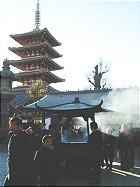 Five storied pagoda Five storied pagoda | 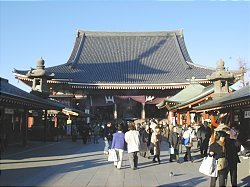 Sensoji maibuilddi Sensoji maibuilddi |
- 12.KAPPA BASHI we drove through this area and saw many places that supply restaurants with wax food samples. It is common to have wax food samples displaying the types of food and drinks served at the restaurant.
Most Japanese restaurants show what they serve by displaying plastic food. The plastic food is quite expensive and very realistic as seen in the pictures below.


- 13. UENO AND AKIHABARA
 |
| Akihabara |
- UENO is a popular amusement and shopping district with all kinds of goods sold at reasonable prices. While AKIHABARA is a world famous district with hundreds of shops for electric appliances. I went to the largest Electronics store in Asia it was 8 floors high with tons of unusual items thaaren'tnt found in the US. Like heated Toilet seats with buttons to activate other features on the toilet.
After my shopping excursion I went down to Roppongi Hills area. This area is commonly known to housforeignersrs. This area is also known for the night life. When I got off the subway I randomly ran into my room mates and we decided to have a drink. We found this one bar called Propaganda. We where a little early for the bar scene because it starts at 11. This is a problem when you rely on the subway system that shuts down at 12. After a few beers we decided to get some dinner. We had, what Americans call Sushi but here in Japan it is referred to as, Sashimi- Sliced raw fish eaten after being dipped in soy sauce mixed with wasabi. Among the most popular fish are tuna, yellowtail and cuttlefish. The service at the restaurant waunusuallyly bad! We all felt discriminated against which was more than likely happening. We where the only white people in the restaurant and where served way after people who came in after us. This was the first time any of the group felt that way. We staid out till 11 and made our way back home. We where all exhausted but made our way home!


















